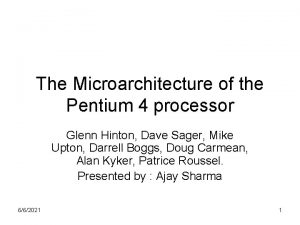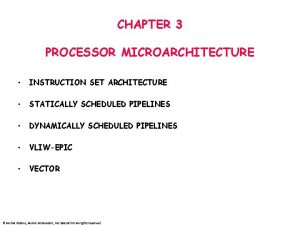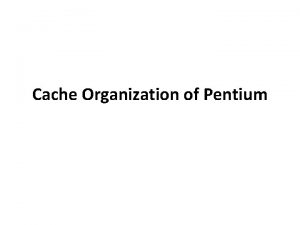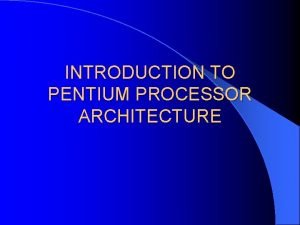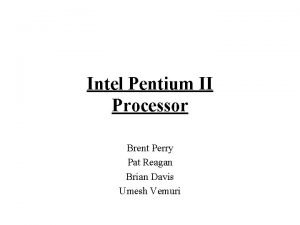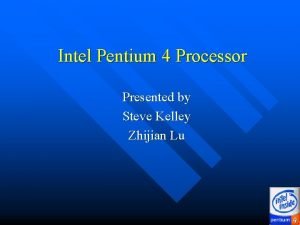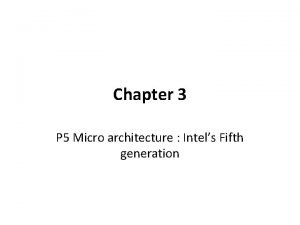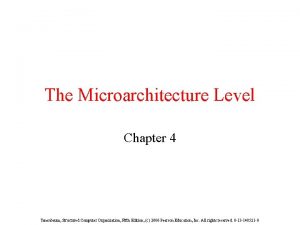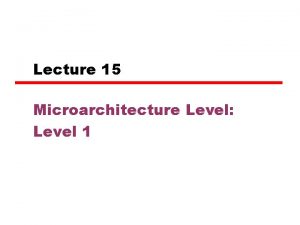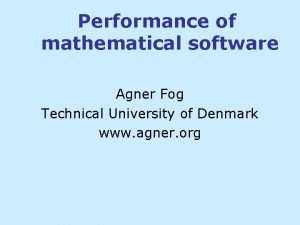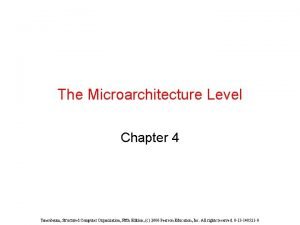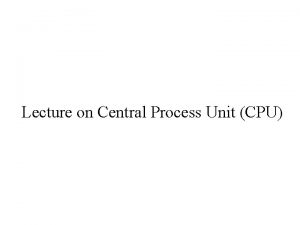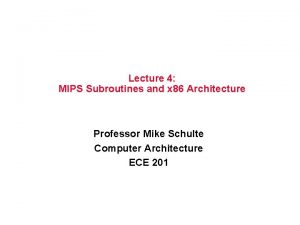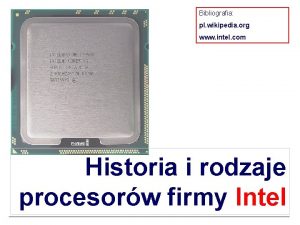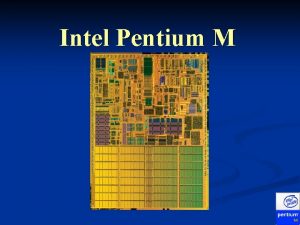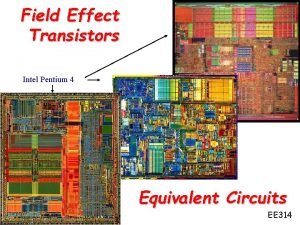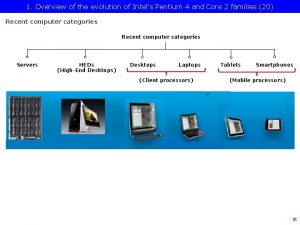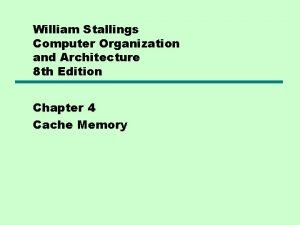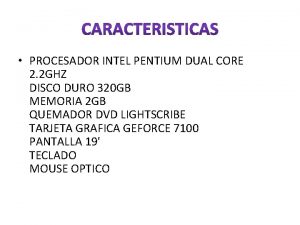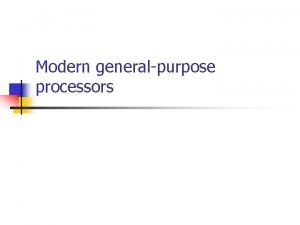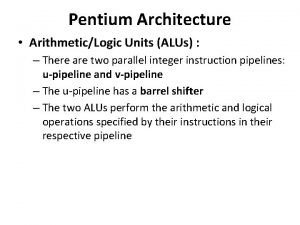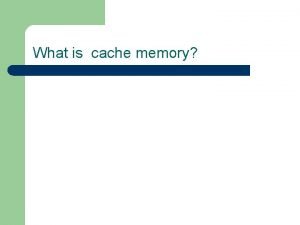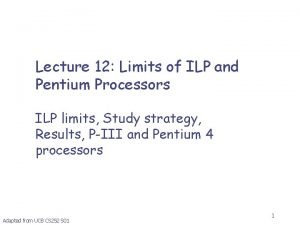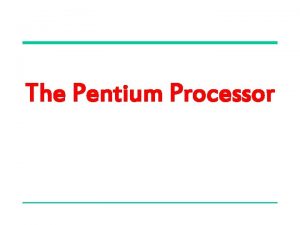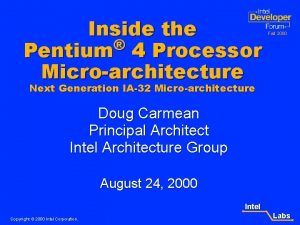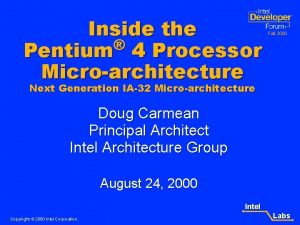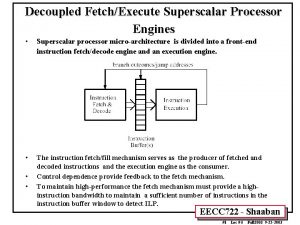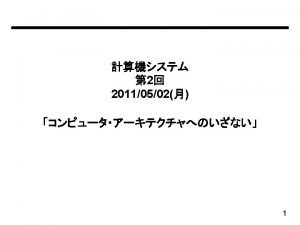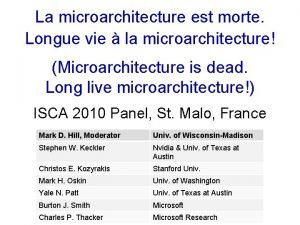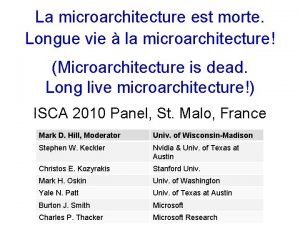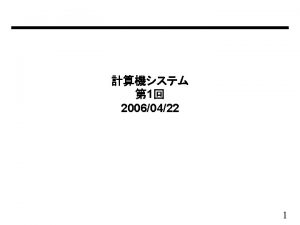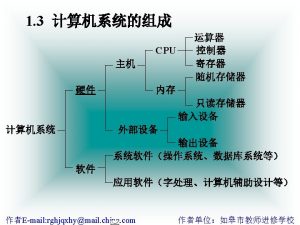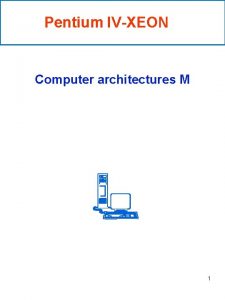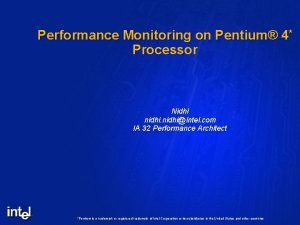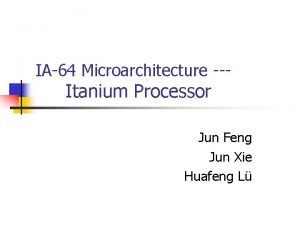The Microarchitecture of the Pentium 4 processor Glenn






























- Slides: 30

The Microarchitecture of the Pentium 4 processor Glenn Hinton, Dave Sager, Mike Upton, Darrell Boggs, Doug Carmean, Alan Kyker, Patrice Roussel. Presented by : Ajay Sharma 6/6/2021 1

Overview of the Netburst™ Micro-Architecture System Bus Level 1 Data cache Bus Unit Execution Unit Level 2 Cache Memory Subsystem Fetch/ Decode Trace cache BTB/Branch Prediction Front End 6/6/2021 Integer & FP Execution Units Out of order Execution Logic Retire ment Branch History Update Out of order Engine 2

In-Order Front End • Fetches the Instructions, decode them and send them to the out of order execution core. • There are three parts to it: 1. Fetch/Decode Unit. 2. Execution Trace cache. 3. BTB/Branch Prediction 6/6/2021 3

Out of Order Engine • This is where the Instructions are prepared for execution. • There are two parts to it: 1. Out of order Execution Logic -> Allows maximum Utilization 1. Retirement Unit -> Ensures that the Instruction are back in order. 6/6/2021 4

Integer and Floating-Point Units • This is the Unit where the Instructions are actually executed. • It has two parts: 1. L-1 data cache 2. Execution Unit 6/6/2021 5

Memory Subsystem • It does many things like store the Instructions in the Level 2 cache when the Trace cache and the L 1 cache is filled. • It also is used to access the main memory when the L 2 cache has a cache miss and the System I/O resources. 6/6/2021 6

Clock Rates • Clock rates determine the stages of pipeline. • Higher clock rate actually require deeper pipeline and more time for cache miss and mispredicted branch. • But overall they are performance booster. • Say 50% increase in frequency results in only 30% increase in the Net Performance but that is still good. 6/6/2021 7

Clocking trends • The clock rates have increased by 2. 5 times from original in 286. 6/6/2021 8

Misprediction Pipeline As the No of Pipeline increase we can do more work per clock and so the clock rate increases. 6/6/2021 9

Net. Burst™ Micro. Architecture 6/6/2021 10

1. Front End • • • Front End BTB & Instruction TLB: Steer the front-end when a cache miss happens. ITLB translates the Linear address to physical address. Trace cache: Only decoded instructions are stored in this cache and when there is a mis-prediction there is no need to re-decode the instruction and so decode latency is reduced. Trace Cache BTB: The Instructions in the cache are predicted for branch taken/not taken. So that the delay can be reduced. Microcode ROM: This is used for complex instruction execution. µop Queue: This holds in-order µOPs from trace cache and microcode ROM before they are sent to the out-of-order execution unit. 6/6/2021 11

2. Out Of order Execution Logic Allocator: It attempts to allocate as many instructions are possible that have their operands ready. 6/6/2021 12

Mechanism of the Allocator Instructions Allocator Buffer Stalled Instructions If the Register File is busy Register File 6/6/2021 13

Register Renaming Instances of Registers 128 P regs 8 A regs EAX EDX EBP Original Registers EAX EDX EBP 1 EDX 1 EAX 2 EAX 3 EAX 4 1 2 3 4 5 6 7 8 9 EAX EDX EBP Sequence number 9 5 4 Register Alias Table Instance name 6/6/2021 14

2. 1 µOP Scheduling • The Schedular determines when an instruction is ready by looking at the register operands It has Two Structures: 1. µOP Queues 2. µOP Scheduler 6/6/2021 15

2. 1. 1 µOP QUEUES • Two Queues 1. Load and Store Queue (Memory Operation) 2. ALU and Branch Queue (ALU and Branch Instructions) -Both Write and Store in Strict FIFO -But Read Out of Order 6/6/2021 16

2. 1. 2 µOP Schedular • 1. 2. 3. 4. Its Tied to FOUR different Dispatch port. Port 0 Port 1 Load Port Store Port 6/6/2021 17

2. 1 Mechanism of Schedular Arbitate for Ports when the Schedular has ready instructions Schedulars Load Store Port 0 Port 1 2µOP/cycle 1µOP/cycle Total of all : Load + Store + Port 0 + port 1 = 1 + 2 + 2 = 6 instructions/cycles 6/6/2021 18

2. 1. 2. 2 Types Of instruction Dispatched Port 0 ALU 2 x speed Port 1 FP ALU Integer FP Move Operation Execute Load Port Store Port Memory Load into Register 6/6/2021 Memory Store from Register 19

3. Integer and Floating Point Execution Unit This is the Place where the instructions are actually executed. • Handles most common case first It has different types of units 1. Integer Operations Unit 2. L 1 data cache 3. Floating Point Unit 6/6/2021 20

3. 1 Integer Operations Unit 1. Low Latency Integer ALU: 2. Complex Integer Operations: 6/6/2021 21

3. 1. 1 Low Latency Integer ALU: - Designed to Handle common cases first 60 -70% Instructions use the ALU bypass Executes Fully Dependent instructions at 2 times clock rate This core is kept as small as possible Unnecessary hardware kept aside Ex: Multiplier , Shift , Rotate , Branch Processing 6/6/2021 22

3. 1. 2 Complex Integer Operation Unit • • • Shift, Rotate, Multiply, Divide, Branch Address calculation etc. . These Instructions come from the Complex Integer dispatch port. Latency of 4 clocks for shift, rotate operations Multiply- 14 clocks Divide – 60 Clocks 6/6/2021 23

3. 2. Low Latency Level 1(L 1) Cache • • Used for Both Integer and FP loads and stores 4 Way associative cache, write through (Every Data in L 1 written to L 2) 8 K in Size and it is very fast. Instead of having a big slow L 1 cache, one fast and one slow 6/6/2021 24

3. 3. Floating Point (FP)/SSE Execution Unit • Floating Point instructions are executed here • Every Clock 1 instruction can start • Two Execution Port: a. 128 bit General Execution b. 128 bit register moves. 6/6/2021 25

4. Memory Subsystem It is responsible for handling L 1 cache miss and L 2 cache miss. • Two Parts 1. L 2 cache (store data that does not fit in L 1 cache) 2. System Bus (Used to access Main Memory when L 2 cache miss and I/O devices) 6/6/2021 26

4. 1 L 2 Cache • 256/512/1024 KB • Used when there is a cache miss in Trace cache, L 1 cache • Has 128 bytes per cache line (64*2) • Bandwidth – 48 GB/s 6/6/2021 27

4. 2. System Bus • Used for Accessing the Main memory when there is a L 2 cache miss. • Used also for accessing the i/o devices • Bandwidth – 3. 2 GB/s • Width – 64 Bits • Clock rate – 400 MHz 6/6/2021 28

Performance • Delivers highest Performance in the world(SPECint_base). • SPECfp 200 performance is also good • 15 -20% gain in Integer performance over PIII • 30 -70% gain in Floating & Mutlimedia performance over PIII • 5% gain in SSE/SSE 2 over x 87 only version 6/6/2021 29

Thank you Questions? 6/6/2021 30
 Pentium 4 microarchitecture
Pentium 4 microarchitecture Instruction types
Instruction types In pentium data cache is of
In pentium data cache is of Introduction to pentium processor
Introduction to pentium processor Intel pentium processor
Intel pentium processor 8086 vs 80386
8086 vs 80386 Pentium 4 processor
Pentium 4 processor Pentium pipeline stages
Pentium pipeline stages Pentium processor family
Pentium processor family Computer microarchitecture
Computer microarchitecture The layout of the microinstruction for mic-1
The layout of the microinstruction for mic-1 Anger fog
Anger fog Isa vs microarchitecture
Isa vs microarchitecture Microarchitecture diagram
Microarchitecture diagram Intel pentium
Intel pentium Pentium mips
Pentium mips Pentium 1
Pentium 1 Intel pentium
Intel pentium Intel pentium 4 wiki
Intel pentium 4 wiki Laptop nn32 bit
Laptop nn32 bit Pentium 4 transistors
Pentium 4 transistors Intel pentium
Intel pentium Pentium evolution
Pentium evolution Pentium 4 cache organization
Pentium 4 cache organization Linux for pentium 4
Linux for pentium 4 Intel pentium
Intel pentium Compaq presario pentium 2
Compaq presario pentium 2 Paralleilism
Paralleilism Pentium architecture
Pentium architecture Pentium iii
Pentium iii Pentium 4 block diagram
Pentium 4 block diagram
